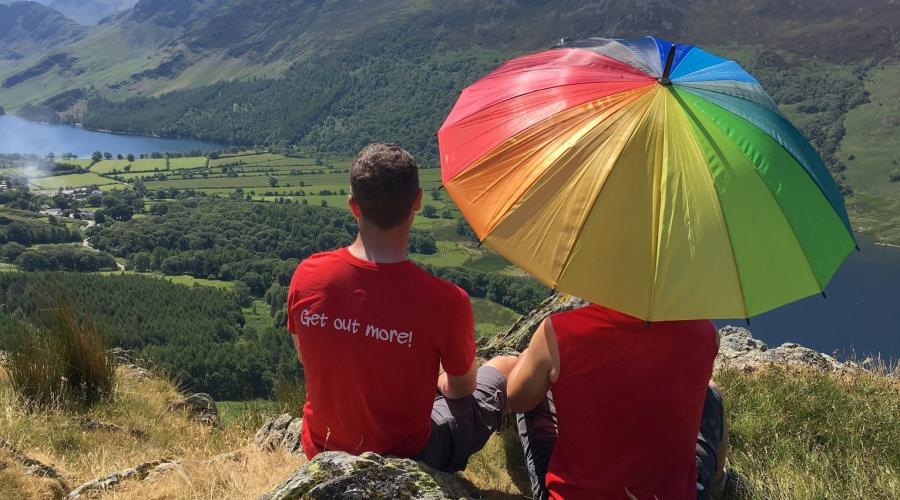A Sublime Wintertime Climb for a Leith Hill Heath Chill
32 people attending
0 places left
1 person waitlisted
We'll take it gently. We'll use tarmac lanes towards it and gravel paths across it. We'll have a pub lunch halfway round. We'll take those memorable steps down rather than up. As a result this clamber up Leith Hill will be strenuous but not too arduous. We'll never be less than 100 metres above sea level, and at the top of the southeast's preeminent promontory we'll be 294 metres above it (or 313 if you go up the tower). A demanding yet rewarding walk: superb views southwards across the Weald and northwards to the capital; an abundance of turn-of-the-century domestic design; an idyllic lake that looks like it's in Wales; a secluded pub for lunch; a sprinkling of the customary OutdoorLads magic.
The sights:
Coldharbour: An amazing place; stone houses perched 230 metres up on the southern slopes of Leith Hill, unlike anything else in southern England. More like Shropshire than Surrey. Remote and unsuburbanised.
Leith Hill: The National Trust reports: '...from the tower...you can see sweeping views towards London in the North and the English Channel in the South. The top of the tower is the highest point in South-East England...Leith Hill is within an Area of Outstanding Natural Beauty (AONB) and is home to abundant wildlife.' The gothick-style tower was built in 1765-6 to raise the height of the hill above 1000 feet. Thirteen counties may be seen from the top on a clear day, it is claimed.
Friday Street: A group of cottages in a wonderful location by a pond at the head of a steep wooded valley. The 80s BBC science fiction series The Tripods was partly filmed here (pre-credits sequence). The pond is a hammer pond; constructed to drive a hammer at a forge. The waterfall was created by the diarist John Evelyn in around 1650 as an ornament to his estate at Wotton House.
Abinger: A scattered village with three centres. Suburbanised but cosy and comfortable, especially the area near the pub, church, village green and well. St James' Church was Norman, bombed in the war and sensitively restored in 1950. Striking and modern stained glass. Goddards is a large house of 1898-9 by Edwin Lutyens designed in an arts and crafts style with gardens by Gertrude Jeykll.
The route:
Heading out west from Holmwood Station along Moorhurst lane we'll reach Anstie Lane which will take us to Coldharbour by following it northwest. This will then be the edge of the open access land of Leith Hill and Coldharbour Common which we'll cross via Wolvens Lane. We'll then cross Simon's Copse to Home Farm to see the waterfall. After using footpaths to cross Broadmoor and Severells Copse, we'll reach Friday Street. Then it'll be on to Abinger Common for the pub lunch.
After lunch we'll follow Abinger Common Road and then a bridleway along Abinger Bottom and across Leith Hill to the Tower which we should have time to ascend and perhaps get tea. We'll then descend using the steps, cross Mosses Wood and continue back to the station at Holmwood across Bushy Copse and Nob's Copse, rejoining Moorhurst Lane just after Moorhurst Farm.
(All images are from Google Image Search and are labelled 'Free to share and use'.)


What to bring
Footwear: Walking boots are essential, along with thick socks to prevent blisters, as the terrain is very hilly.
Clothing: Wear cold and wet weather gear if these conditions are forecast and consider gaiters to reduce the spread of mud up the legs (the terrain will be muddy in parts although much of the walk will be on tarmac and gravel). Waterproof trousers are useful in the wettest weather but avoid jeans as when they are wet they become cold, heavy and chafing.
Food & drink
Please bring drinks and snacks. We are booked in to have lunch at The Abinger Hatch pub at Abinger Common. Please choose from below what you'd like to eat. Alternatively, you are welcome to have a packed lunch. We might get time to have tea from the servery at Leith Hill Tower and ascend the tower.
RAMBLERS' LIGHT BITE MENU (1 course and a drink for £11.50)
DRINKS
Pint of Razorback, Amstel, Fosters, Estrella, Guinness or guest cask, 175ml glass of Merlot, Grenache, Pinot Grigio, Macabeo or Pinot Blush; Any soft drink, tea or coffee
FOOD
Cured Salmon Bagel – Beetroot cured salmon, thyme cream cheese side salad & crisps
Club Bagel - Buttermilk chicken, devilled eggs, smoked bacon, baby gem, garlic mayo, side salad & crisps
American Deli Bagel – Pastrami, pickles, sauerkraut, mustard mayo, cheddar cheese, side salad & crisps
Fish Finger Bagel – Breaded mackerel fingers, tartare sauce, side salad & crisps
Goats Cheese Bagel – Creamy goats cheese, red onion chutney, rocket, tomato, side salad & crisps
“BLT” Bagel – Smoked bacon, dirty vicar cheese, lettuce, tomato, cranberry, side salad & crisps
Soup of the Day with home-made foccacia
BBQ Pulled Pork Scotch Egg – Chilli Jam, watercress
Smoked Haddock & Cheddar Fondue - Toasted foccacia
Black Pudding Rosti - Grilled poached pear, béarnaise sauce
Chicken Liver Parfait - Melba toast, real ale chutney
RAMBLERS' LUNCH MENU (1 course and a drink for £16.00)
DRINKS
Pint of Razorback, Amstel, Fosters, Estrella, Guinness or guest cask, 175ml glass of Merlot, Grenache, Pinot Grigio, Macabeo or Pinot Blush; Any soft drink, tea or coffee
FOOD
Chef’s Pie of the Day - Mash potato, seasonal greens (please allow 25 minutes to cook)
Chunky Chilli Con Carne - Corn tortillas, white rice
Home roasted Ham, Egg & Chips - Fried eggs, chunky chips
Fisherman’s Pie - Truffle oil & cheddar mash top, cabbage (please allow 25 minutes to cook)
Beef, Chipotle Chicken or Vegetarian Burger - Cheddar cheese, baby gem, gherkin, tomato, red onion, aioli, fries, coleslaw
Beer Battered Fish & Chips - Chunky chips, mushy peas, tartare sauce, lemon wedge
Hog Roast Sausages & Mash - Buttermilk pickled onion rings, ale gravy
Truffle Mac ‘n’ Cheese - Bacon & thyme crumb, garlic foccacia, mixed leaf salad
Goats Cheese Salad (V) - Ruby beetroots, charred shallots, piquillo peppers, watercress, sun-dried tomatoes, green beans
Pan Roasted Polenta (VE) - Roasted red peppers, tomato & basil puree, kale herb dressing, pumpkin seeds